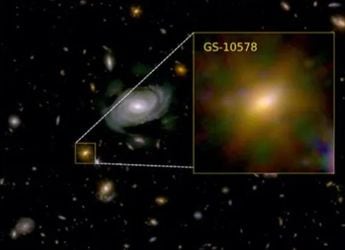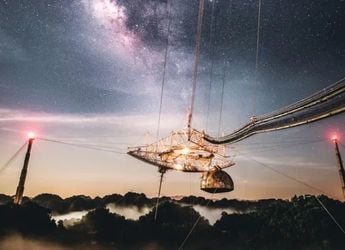- Home
- Science
- Science News
- James Webb Space Telescope Captures Closest Star Forming Region to Earth, NASA Releases Image
James Webb Space Telescope Captures Closest Star-Forming Region to Earth, NASA Releases Image
The James Webb Space Telescope telescope was launched in 2021 and began collecting data last year.

Photo Credit: Reuters
Rho Ophiuchi cloud complex, closest star-forming region to Earth, seen by the James Webb Space Telescope
NASA on Wednesday released an image obtained by the James Webb Space Telescope of the Rho Ophiuchi cloud complex, the closest star-forming region to Earth, as the U.S. space agency marked one year since it unveiled the telescope's first scientific results.
The Webb telescope, which was launched in 2021 and began collecting data last year, has reshaped the understanding of the early universe while taking stunning pictures of the cosmos.
The Rho Ophiuchi image was an example of that, showing a nebula - a humongous cloud of interstellar gas and dust that serves as a nursery for new stars - located in our Milky Way galaxy roughly 390 light years from Earth. A light year is the distance light travels in a year, 5.9 trillion miles (9.5 trillion km).
Rho Ophiuchi is only about a million years old, a blink of an eye in cosmic time.
"Here, we see how new suns are forming, along with planet-forming disks appearing as small dark silhouettes. These are very similar to what we think the solar system looked like more than 4.5 billion years ago," said astronomer and former Webb project scientist Klaus Pontoppidan, who is now a research scientist at NASA's Jet Propulsion Laboratory.
"As the stars and planetary systems assemble, they blow apart the dusty cocoon from which they formed in violent outbursts, as seen in red jets ploughing through the cloud as a boat in the water. The Rho Ophiuchi core is completely obscured by huge amounts of dust, so it is essentially invisible to telescopes working in visible light, like the Hubble telescope. Yet, Webb peers through the dust to reveal the young stars within, showing the very first stages in the life of every star," Pontoppidan added.
The image, obtained in March and April of this year, shows how the jets of material emanating from young stars affect the surrounding gas and dust while lighting up molecular hydrogen. In one part of the image, a star is seen inside a glowing cave that its stellar winds carve out in space.
"You see an almost impressionistic nebula crowned by three bright young stars on the top. We were surprised by the size and detail of the jets and outflows," Pontoppidan said.
Since becoming operational, Webb has revealed the existence of the earliest-known galaxies and black holes. It has observed large and mature but remarkably compact galaxies teeming with stars that had formed within a few hundred million years of the Big Bang event that marked the beginning of the universe about 13.8 billion years ago - far sooner than scientists had considered possible.
"Some would say there are few parts of astrophysics that have not been touched by Webb in one way or another. Prominent results include the discovery of new galaxies and black holes in the early universe and new views into exoplanetary atmospheres. The Rho Ophiuchi images shows how Webb gives us a new window into the formation of stars and planets," Pontoppidan said.
The orbiting observatory was designed to be far more sensitive than its Hubble Space Telescope predecessor. Webb looks at the universe mainly in the infrared, while Hubble has examined it primarily at optical and ultraviolet wavelengths. Webb is able to look at greater distances and thus farther back into time than Hubble.
"In just one year, the James Webb Space Telescope has transformed humanity's view of the cosmos, peering into dust clouds and seeing light from faraway corners of the universe for the very first time," NASA Administrator Bill Nelson said in a statement. "Every new image is a new discovery, empowering scientists around the globe to ask and answer questions they once could never dream of."
© Thomson Reuters 2023
(This story has not been edited by NDTV staff and is auto-generated from a syndicated feed.)
Catch the latest from the Consumer Electronics Show on Gadgets 360, at our CES 2026 hub.
Related Stories
- Samsung Galaxy Unpacked 2025
- ChatGPT
- Redmi Note 14 Pro+
- iPhone 16
- Apple Vision Pro
- Oneplus 12
- OnePlus Nord CE 3 Lite 5G
- iPhone 13
- Xiaomi 14 Pro
- Oppo Find N3
- Tecno Spark Go (2023)
- Realme V30
- Best Phones Under 25000
- Samsung Galaxy S24 Series
- Cryptocurrency
- iQoo 12
- Samsung Galaxy S24 Ultra
- Giottus
- Samsung Galaxy Z Flip 5
- Apple 'Scary Fast'
- Housefull 5
- GoPro Hero 12 Black Review
- Invincible Season 2
- JioGlass
- HD Ready TV
- Laptop Under 50000
- Smartwatch Under 10000
- Latest Mobile Phones
- Compare Phones
- Samsung Galaxy A07 5G
- Vivo Y500i
- OnePlus Turbo 6V
- OnePlus Turbo 6
- Itel Zeno 20 Max
- OPPO Reno 15 Pro Mini 5G
- Poco M8 Pro 5G
- Motorola Signature
- Lenovo Yoga Slim 7x (2025)
- Lenovo Yoga Slim 7a
- Realme Pad 3
- OPPO Pad Air 5
- Garmin Quatix 8 Pro
- NoiseFit Pro 6R
- Haier H5E Series
- Acerpure Nitro Z Series 100-inch QLED TV
- Asus ROG Ally
- Nintendo Switch Lite
- Haier 1.6 Ton 5 Star Inverter Split AC (HSU19G-MZAID5BN-INV)
- Haier 1.6 Ton 5 Star Inverter Split AC (HSU19G-MZAIM5BN-INV)

















